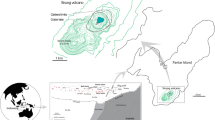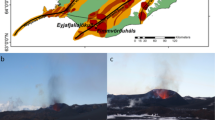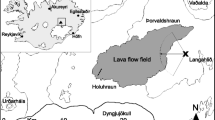Abstract
This paper describes how observations of sulfur dioxide (SO2) degassing rates (obtained in situ), thermal emission rates (obtained from infrared satellite data), and semiquantitative flow field observations can be used to elucidate the partitioning of lava between the surface and tube systems at Kīlauea volcano, Hawai’i, over a decadal timescale. For most of our study period, 2000 to 2009, we found that the infrared spectral radiance measured by Moderate Resolution Imaging Spectroradiometer from the flow field under clear-sky conditions is controlled by the lava effusion rate and the amount of flow accommodated by the subsurface tube system. At Kīlauea, the degree of tubing is estimated qualitatively using field observations, and we show that the satellite data and in situ gas data can be used to estimate the percentage of lava on the surface relative to the total amount erupted. This empirical relationship works to describe many cases in the past decade at Kīlauea but breaks down when there is a lack of concurrent clear-sky radiance and SO2 data or when magma is being stored and degassed prior to eruption. Our observations provide a simple way to estimate the partitioning of Kīlauea’s total lava supply between surface and tube-fed flows using a long-term dataset. This is important because the transition between periods when lava is distributed primarily by surface flows to periods where tubes dominate has been suggested to indicate significant changes in the character of decadal-scale eruptions at Kīlauea (Heliker et al., Bull Volcanol 59:381–393, 1998). In addition, it is during those times when surface flows predominate that the flow field does most of its lateral expansion and the hazards associated with the lava effusion become more pronounced.













Similar content being viewed by others
References
Barnes WL, Pagano TS, Salomonson VV (1998) Prelaunch characteristics of the Moderate Resolution Imaging Spectroradiometer (MODIS) on EOS-AM1. IEEE Trans Geosci Remote Sens 36:1088–1100
Carn SA, Lopez TM (2011) Opportunistic validation of sulfur dioxide in the Sarychev Peak volcanic eruption cloud. Atmos Meas Tech 4:1705–1712
Cervelli PF, Miklius A (2003) The shallow magmatic system of Kīlauea volcano. In: Heliker C, Swanson DA, Takahashi TJ (eds) The Pu‘u ‘Ō‘ō–Kūpaianaha eruption of Kīlauea volcano, Hawai‘i: the first 20 years. USGS Professional Paper 1676, pp 149–164
Elias T, Sutton AJ, Stokes JB, Casadevall TJ (1998) Sulfur dioxide emission rates of Kīlauea volcano, Hawai‘i, 1979–1997. US Geological Survey Open-File Report 98-462, 40 pp
Elias T, Sutton AJ (2002) Sulfur dioxide emission rates from Kīlauea volcano, Hawai‘i, an update: 1998–2001. US Geological Survey Open-File Report 02-460, 10 pp
Elias T, Sutton AJ (2007) Sulfur dioxide emission rates from Kīlauea volcano, Hawai‘i, an update: 2002–2006. US Geological Survey Open-File Report 2007-1114, 37 pp
Harris AJL, Flynn LP, Keszthelyi L, Mouginis-Mark PJ, Rowland SK, Resing JA (1998) Calculation of lava effusion rates from Landsat TM data. Bull Volcanol 60:52–71
Harris AJL, Dehn J, Calvari S (2007) Lava effusion rate definition and measurement: a review. Bull Volcanol 70:1–22
Heliker C, Mattox TN (2003) The first two decades of the Pu‘u ‘Ō‘ō–Kupaianaha eruption: chronology and selected bibliography. In: Heliker C, Swanson DA, Takahashi TJ (eds) The Pu‘u ‘Ō‘ō–Kūpaianaha eruption of Kīlauea volcano, Hawai‘i: the first 20 years. USGS Professional Paper 1676, pp 1–28
Heliker CC, Mangan MT, Mattox TN, Kauahikaua JP, Helz RT (1998) The character of long-term eruptions: inferences from episodes 50–53 of the Pu‘u ‘Ō‘ō–Kūpaianaha eruption of Kīlauea Volcano. Bull Volcanol 59:381–393
Heliker C, Kauahikaua J, Sherrod DR, Lisowski M, Cervelli P (2003) The rise and fall of Pu‘u ‘O‘o cone, 1983–2002. In: Heliker C, Swanson DA, Takahashi TJ (eds) The Pu‘u ‘Ō‘ō–Kūpaianaha eruption of Kīlauea volcano, Hawai‘i: the first 20 years. USGS Professional Paper 1676, pp 29–52
Hon KA, Kauahikaua JP, Denlinger RP, Mackay K (1994) Emplacement and inflation of pahoehoe sheet flows; observations and measurements of active lava flows on Kilauea volcano. Hawaii Geol Soc Am Bull 106:351–370
Houghton BF, Swanson DA, Carey RJ, Rausch J, Sutton AJ (2011) Pigeonholing pyroclasts: insights from the 19 March 2008 explosive eruption of Kilauea volcano. Geology 39:263–266
Kauahikaua JP, Mangan MT, Heliker CC, Mattox TN (1996) A quantitative look at the demise of a basaltic vent; the death of Kūpaianaha, Kīlauea Volcano, Hawai‘i. Bull Volcanol 57:641–648
Kauahikaua J, Sherrod DR, Cashman KV, Heliker C, Hon K, Mattox TN, Johnson JA (2003) Hawaiian lava-flow dynamics during the Pu‘u ‘Ō‘ō–Kūpaianaha eruption: a tale of two decades. In: Heliker C, Swanson DA, Takahashi TJ (eds) The Pu‘u ‘Ō‘ō–Kūpaianaha eruption of Kīlauea volcano, Hawai‘i: the first 20 years. USGS Professional Paper 1676, pp 63–88
Kauahikaua J (2007) Lava flow hazard assessment, as of August 2007, for Kīlauea east rift zone eruptions, Hawai‘i Island. US Geological Survey Open File Report 2007-1264, 12 pp
Kaufman YJ, Justice CO, Flynn LP, Kendall JD, Prins EM, Giglio L, Ward DE, Menzel WP, Setzer AW (1998) Potential global fire monitoring from EOS-MODIS. J Geophys Res 103:32215–32238
Koeppen WC, Pilger E, Wright R (2010) Time series analysis of infrared satellite data for detecting thermal anomalies: a hybrid approach. Bull Volcanol 73:577–593
Mattox TN, Heliker CC, Kauahikaua JP, Hon KA (1993) Development of the 1990 Kalapana flow field, Kīlauea Volcano, Hawai‘i. Bull Volcanol 55:407–413
Orr TR (2011) Lava tube shatter rings and their correlation with lava flux increases at Kīlauea volcano, Hawai‘i. Bull Volcanol 73:335–346
Orr TR, Patrick MR (2009) What has driven degassing events during the 2008–2009 summit eruption of Kīlauea volcano, Hawai‘i? Abstract V32G-2330 presented at 2009 Fall Meeting, AGU, San Francisco, CA, 14–18 December
Orr TR, Patrick MR, Wooten KM, Swanson DA, Elias T, Sutton J, Wilson DC, Poland MP (2008) Explosions, tephra, and lava: a chronology of the 2008 summit eruption of Kilauea volcano, Hawai'i. Abstract #V11B-2018 presented at 2008 Fall Meeting, AGU, San Francisco, CA, 15–19 December
Patrick MR, Orr T (2011) Rootless shield and perched lava pond collapses at Kīlauea Volcano. Hawai'i Bull Volcanol 74:67–78
Patrick MR, Orr T, Wilson D, Dow D, Freeman R (2011) Cycles of spattering, seismic tremor and surface fluctuation within a perched lava channel, Kīlauea volcano. Bull Volcanol 73:639–653
Pergola N, Marchese F, Tramutoli V (2004) Automated detection of thermal features of active volcanoes by means of infrared AVHRR records. Remote Sens Environ 93:311–327
Pergola N, Giuseppe DA, Lisi M, Marchese F, Mazzeo G, Tramutoli V (2009) Time domain analysis of robust satellite techniques (RST) for near real-time monitoring of active volcanoes and thermal precursor identification. Phys Chem Earth 34:380–385
Poland M, Miklius A, Orr T, Sutton J, Thornber C, Wilson D (2008) New episodes of volcanism at Kilauea Volcano Hawaii. Eos (Am Geophys Union Trans) 89(5):37–38
Poland M, Miklius A, Lundgren P, Sutton AJ (2011) Transient deflation–inflation cycles at Kilauea volcano, Hawaii: what’s up (and down) with that? Abstract V51G-01 presented at 2011 Fall Meeting, AGU, San Francisco, CA, 5–9 December
Poland M, Miklius A, Sutton AJ, Thornber CR (2012) A mantle-driven surge in magma supply to Kīlauea Volcano during 2003–2007. Nature Geosci 5:238–239
Prata AJ, Bluth GJS, Werner C, Realmuto VJ, Carn SA, Watson IM (2013) Gas emissions from volcanoes. In: Dean KG, Dehn J (eds) Monitoring volcanoes in the North Pacific: observations from space. Springer-Praxis Books, Chichester
Steffke A, Harris AJL, Burton MR, Caltabiano T, Salerno GG (2011) Coupled use of COSPEC and satellite measurements to define the volumetric balance during effusive eruptions at Mt. Etna Italy. J Volcanol Geotherm Res 205:47–53
Sutton AJ, Elias T, Gerlach TM, Stokes JB (2001) Implications for eruptive processes as indicated by sulfur dioxide emissions from Kīlauea Volcano, Hawai‘i, 1979–1997. J Volcanol Geotherm Res 108:283–302
Sutton AJ, Elias T, Kauahikaua J (2003) Lava-effusion rates for the Pu‘u ‘Ō‘ō–Kūpaianaha eruption derived from SO2. In: Heliker C, Swanson DA, Takahashi TJ (eds) The Pu‘u ‘Ō‘ō–Kūpaianaha eruption of Kīlauea volcano, Hawai‘i: the first 20 years. USGS Professional Paper 1676, pp 137–148
Sutton AJ, Elias T, Gerlach T, Lee R, Miklius A, Poland MP, Werner CA, Wilson D (2009) Volatile budget of Kilauea volcano receives stimulus from the magma bank. Abstract V52B-08 presented at 2009 Fall Meeting, AGU, San Francisco, CA, 14–18 December
Thornber CR, Heliker C, Sherrod DR, Kauahikaua JP, Miklius A, Okubo PG, Trusdell FA, Budahn JR, Ridley WI, Meeker GP (2003) Kīlauea east rift zone magmatism: an episode 54 perspective. J Petrology 44:1525–1559
Wilson D, Elias T, Orr T, Patrick M, Sutton J, Swanson D (2008) Small explosion from new vent at Kīlauea’s summit. EOS, Transactions American Geophysical Union 89(22):203
Wolfe EW, Neal CA, Banks NG, Duggan TJ (1988) Geologic observations and chronology of eruptive events. In: Wolfe EW (ed) The Pu‘u ‘Ō‘ō eruption of Kīlauea volcano, Hawai‘i, episodes 1–20. US Geological Survey Professional Paper 1463, pp 1–97
Wright R, Blake S, Harris AJL, Rothery DA (2001) A simple explanation for the space-based calculation of lava eruption rates. Earth Planet Sci Lett 192:223–233
Wright R, Flynn L, Garbeil H, Harris A, Pilger E (2002) Automated volcanic eruption detection using MODIS. Remote Sens Environ 82:135–155
Wright R, Flynn L, Garbeil H, Harris A, Pilger E (2004) MODVOLC: near-real-time thermal monitoring of global volcanism. J Volcanol Geotherm Res 153:29–49
Acknowledgments
The authors would like to thank the diligent work of the HVO scientists and volunteers for recording daily observations at Kīlauea. Greg Vaughan (United States Geological Survey) reviewed the paper prior to submission, and Sonia Calvari, Diego Coppola, and an anonymous reviewer produced thoughtful reviews that helped clarify and improve the manuscript. Koeppen and Wright were supported by NASA grant NNX08AF08G. This is HIGP publication #2002 and SOEST publication #8876.
Author information
Authors and Affiliations
Corresponding author
Additional information
Editorial responsibility: S. Calvari
Rights and permissions
About this article
Cite this article
Koeppen, W.C., Patrick, M., Orr, T. et al. Constraints on the partitioning of Kīlauea’s lavas between surface and tube flows, estimated from infrared satellite data, sulfur dioxide emission rates, and field observations. Bull Volcanol 75, 716 (2013). https://doi.org/10.1007/s00445-013-0716-3
Received:
Accepted:
Published:
DOI: https://doi.org/10.1007/s00445-013-0716-3




